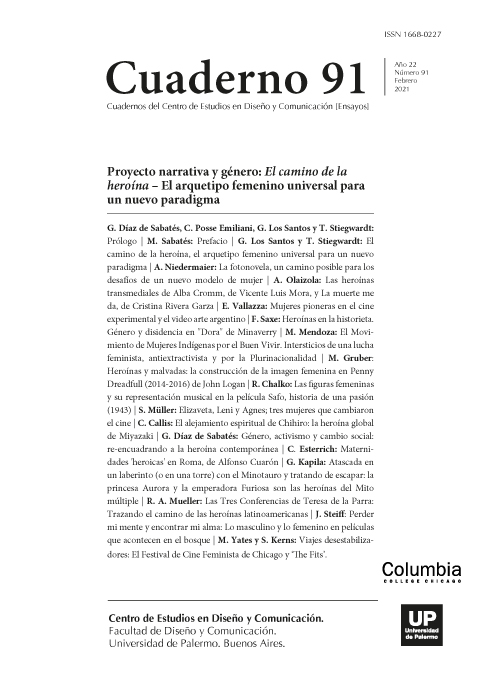Las heroínas transmediales de Alba Cromm, de Vicente Luis Mora, y La muerte me da, de Cristina Rivera Garza
Abstract
In recent years, a growing number of projects, objects, programs, artifacts, works and texts belonging to the cultural sphere have, at one or at all stages of the production process, some transmedia component. Practically, there are no actors in the culture and communication fields "who are not thinking about their production in transmedia terms, from fiction to documentary, through journalism, advertising and political communication" (Scolari, 2014). Regarding the audiovisual industry, for example, "transmedia" has become the "magic word" of any project; in fact, "in some moments it seems as if something could not be done in a single medium" (Tubau, 2011).
The literary system has also integrated transmedia as an element or an aesthetic process. The story, but also a similar aesthetic, rhetoric or theme, extend beyond the margins of the literary text to other media, each of which does not lose its autonomy and specificity. In turn, transmedia also articulates "modes of reciprocal and procedural affectation between media, languages and technologies", which strongly destabilize their origin spaces (Kozak, 2015): literary texts, which often function as start windows, change in the transmedia process.
The following article will analyzed how transmedia functions in two contemporary novels written in Spanish: La muerte me da (2007), by Mexican author Cristina Rivera Garza; and Alba Cromm (2010), by Spanish author Vicente Luis Mora. In addition to describing the transmedia system, the article will emphasized on how transmedia establishes as a core component in the conformation of the novels’ heroines.
References
Bourriaud, N. (2009). Radicante. Traducción de Michele Guillemont. Buenos Aires: Adriana Hidalgo.
Courtis, A.; Mendoza, J. J. (2015). DBP. Buenos Aires-Bahía Blanca: Vox.
Rivera Garza, C. (2011). Las aventuras de la Increíblemente Pequeña. Recuperado desde http://increiblementepequena-blog.tumblr.com/
Gallego Aguilar, A. F. (2011). Diseño de narrativas transmediáticas. Manizales: Facultad de Artes y Humanidades, Universidad de Caldas.
Gómez, S. (2016). Exonovela: ¿síntoma de una nueva narrativa del siglo XX. Boletín Hispánico Helvético. Dossier El impacto de las nuevas tecnologías sobre los procesos de lectura y escritura, 28 (otoño), pp. 219-231.
Jenkins, H. (2008). Convergence culture: la cultura de la convergencia de los medios de comunicación. Barcelona: Paidós.
Jenkins, H. (2009, September 10). The Aesthetics of Transmedia. Response to David Bordwell (Part One). Confessions of an Aca-Fan. Recuperado desde http://henryjenkins.org/blog/2009/09/the_aesthetics_of_transmedia_i.html
Jenkins, H.; Clinton, K.; Purushotma, R.; Robinson, A. J.; Weigel, M.. (2006). Confronting the Challenges of Participatory Culture: Media Education for the 21st Century. Chicago: The MacArthur Foundation.
Klastrup, L. & Tosca, Susana. (2004). Transmedial Worlds: Rethinking Cyberworld Design. 2004 International Conference on Cyberworlds. Recuperado desde http://www.itu.dk/people/klastrup/klastruptosca_transworlds.pdf
Kozak, C. (2009). Poéticas tecnológicas y escuela. Apuntes sobre canon y experimentación. Propuesta educativa, N° 32 (noviembre), pp. 47-53.
Kozak, C. (Comp.). (2011). Poéticas tecnológicas, transdisciplina y sociedad. Actas del Seminario Internacional Ludión/Paragraphe. Buenos Aires: Exploratorio Ludión.
Kozak, C. (Ed.). (2014). Poéticas/políticas tecnológicas en Argentina. 1910-2010. Paraná: La Hendija.
Kozak, C. (Ed.). (2015). Tecnopoéticas argentinas.Archivo blando de arte y tecnología. Buenos Aires: Caja Negra Editora.
Laddaga, R. (Cur.). (2013). Cosas que un mutante debe saber. Más cuentos breves y extraordinarios. Amsterdam: Unsounds.
Manovich, L. (2006). El lenguaje de los nuevos medios de comunicación: la imagen en la era digital. Buenos Aires: Paidós.
Mendoza, J. J. (2011). Escrituras past_. Tradiciones y futurismos del siglo 21. Bahía Blanca: 17g Editora.
Mendoza, J. J. (2015). Diario de un bebedor de petróleo. Buenos Aires-Bahía Blanca: Vox.
Mora, V. L. (2010). Alba Cromm. Barcelona: Seix Barral.
Mora, V. L. (2012). El lectoespectador. Deslizamientos entre literatura e imagen. Barcelona: Seix Barral.
Nallar, D. A. (2016). Diseño de juegos en América latina. Teoría y práctica. II. Diseño y narrativa transmedia. Florida: Game Design LA.
Olaizola, A. (2018). Transmedialidad en “tecnonarrativas” hispánicas del siglo XXI. Catálogo de Investigación DC. Recuperado desde https://fido.palermo.edu/servicios_dyc/catalogo_investigacion/detalle_proyecto.php?id_proyecto=4905&titulo_proyectos=Transmedialidad%20en%20%93tecnonarrativas%94%20hisp%E1nicas%20del%20siglo%20XXI
Olaizola, A. (2019). “Monstruos literarios tecnotextuales: Internet y las narrativas tecnológicas del siglo XXI”. Revista Luthor, 39 (febrero). Recuperado desde http://www.revistaluthor.com.ar/spip.php?article207
Pantel, A. (2014). Alba Cromm de Vicente Luis Mora: ¿una novela aumentada? En Marco Kunz y Sonia Gómez. (Eds.). Nueva narrativa española. Barcelona: Linkgua, pp. 155-169.
Producers Guild of America. (2010, April 6). PGA Board of Directors Approves Addition of Transmedia Producer to Guild's Producers Code of Credits. Producers Guild of America. Recuperado desde https://www.producersguild.org/news/news.asp?id=39637&hhSearchTerms=%22transmedia%22
Rivera Garza, C. (2007). La muerte me da. Barcelona: Tusquets.
Rivera Garza, C. (2008). La frontera más distante. Barcelona: Tusquets.
Rivera Garza, C. (2012). El mal de taiga. Barcelona: Tusquets.
Ryan, M.-L. (2013). Transmedial Storytelling and Transfictionality. Poetics Today, 34, 3, pp. 362-388.
Ryan, M.-L. (2016). Transmedia narratology and transmedia storytelling. Artnodes, Nº 18
Sánchez Aparicio, V. (2014). Y en el principio era Tlön: transmedia de origen literario en las narrativas hispánicas. Caracteres. Estudios culturales y críticos de la esfera digital. Monográfico: Universos transmedia y convergencias narrativas, Vol. 3, Nº1 (mayo), pp. 61-80.
Sánchez Becerril, I. (2013). Subversión del género en La muerte me da, de Cristina Rivera Garza, y Efectos secundarios, de Rosa Beltrán. En C. Reverte Bernal. (Ed.). Diálogos culturales en la literatura iberoamericana. Actas del XXXIX Congreso del Instituto Internacional de Literatura Iberoamericana. Madrid: Verbum, pp. 1264-1275.
Scolari, C. A. (2013). Narrativas transmedia. Cuando todos los medios cuentan. Barcelona: Deusto.
Scolari, C. A. (2014). Narrativas transmedia: nuevas formas de comunicar en la era digital Anuario AC/E de Cultura Digital 2014, pp. 71-81.
Todorov, T. (1981). Introducción a la literatura fantástica. Traducción de Silvia Delphy. México DF: Premia.
Tubau, D. (2011). El guion del siglo XXI. El futuro de la narrativa en el mundo digital. Barcelona: Alba.
Los autores/as que publiquen en esta revista ceden los derechos de autor y de publicación a "Cuadernos del Centro de Estudios de Diseño y Comunicación", Aceptando el registro de su trabajo bajo una licencia de atribución de Creative Commons, que permite a terceros utilizar lo publicado siempre que de el crédito pertinente a los autores y a esta revista.


